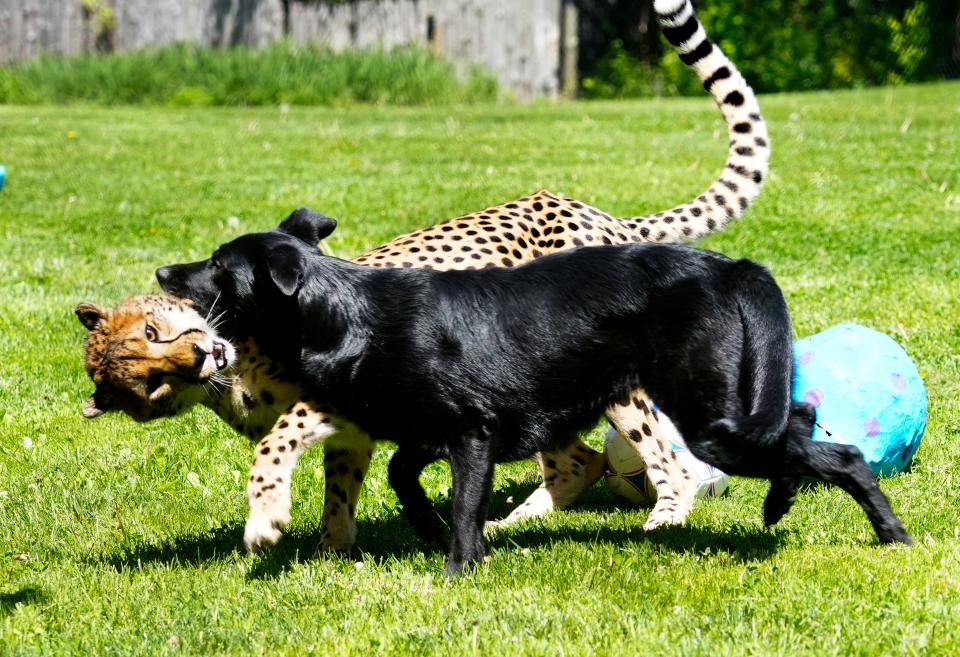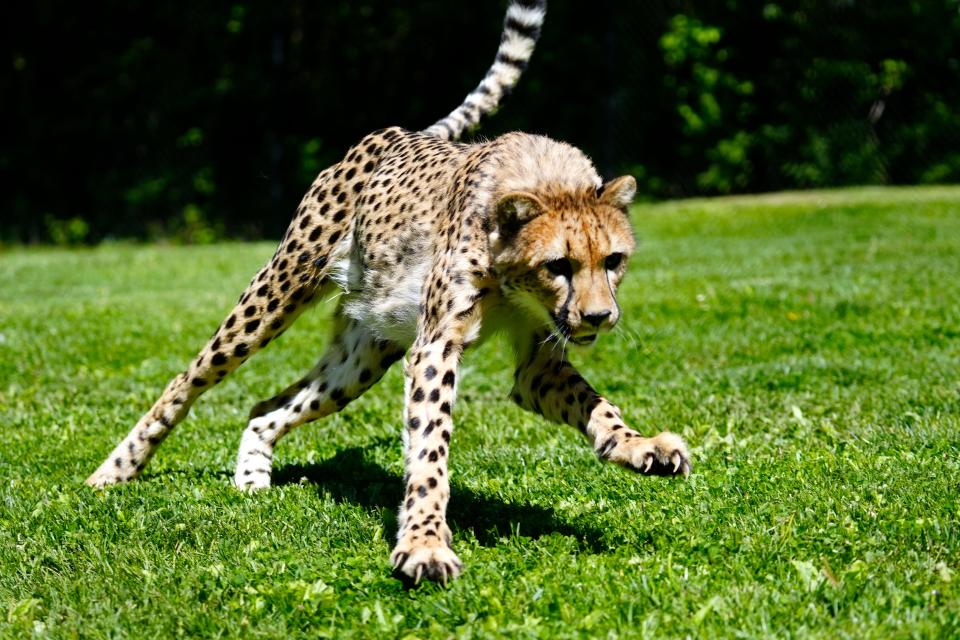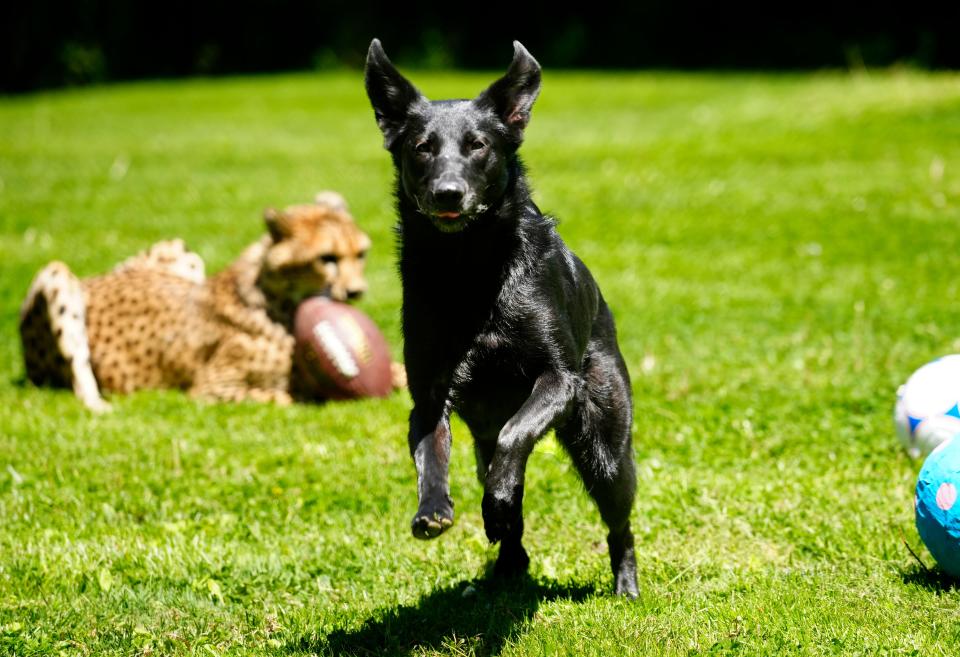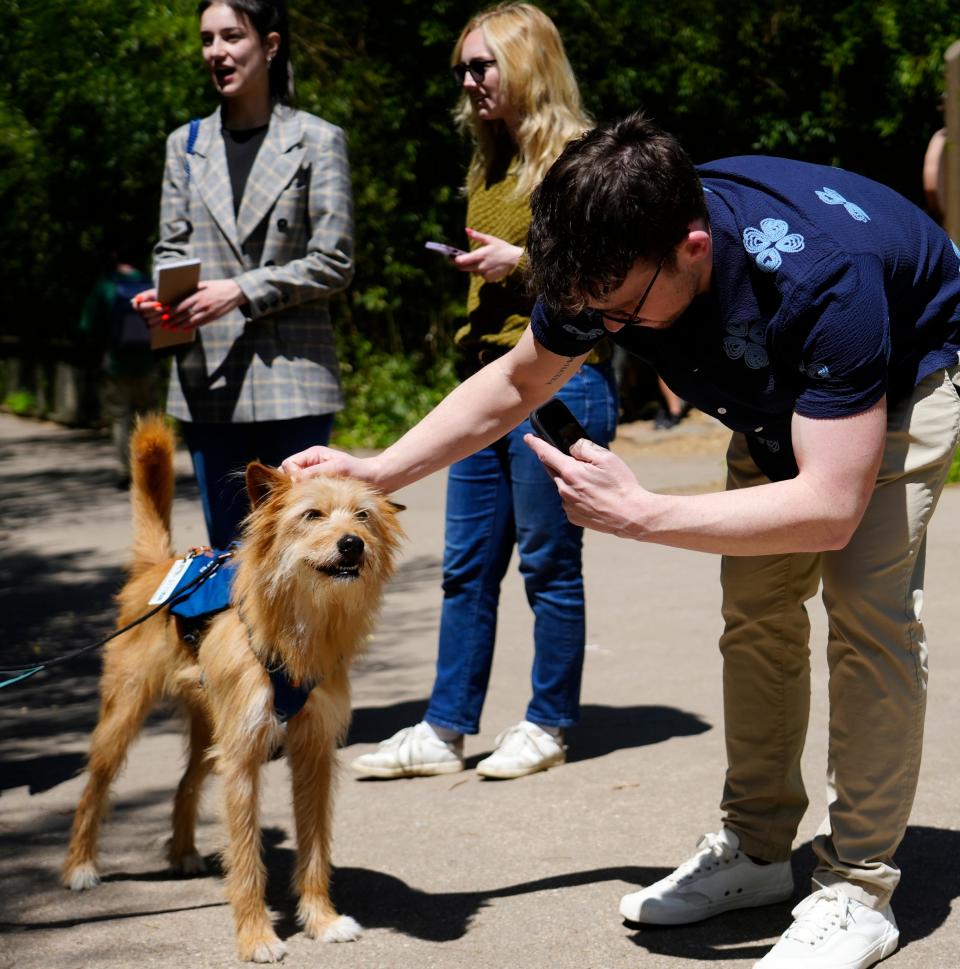Cheetahs and dogs have been pals for decades at the Cincinnati Zoo. We learned how it works
Rozi, a 2-year-old cheetah, came to the Cincinnati Zoo & Botanical Garden from the Wildlife Safari in Oregon in 2022 as a single cub, rejected by her mother. But she wasn't alone for long. Through the zoo's Cat Ambassador Program, Rozi met Daisy, an adopted mixed-breed puppy, and made a once-in-a-lifetime friend.
Cheetahs are, by nature, solitary creatures when they reach maturity around age 2, Andie Haugen, senior trainer at the zoo's Cat Ambassador Program, said. However, they normally grow up with siblings, with whom they play, chase and develop important skills. Since 1981, the Cincinnati Zoo has paired single cheetah cubs with puppies to replicate this bond.
"They're like surrogate siblings, essentially, to the cheetah," Haugen said.
The Enquirer met Remus and Moose, the Cat Ambassador Program's two other dogs, watched Daisy and Rozi play and learned more about the history of this unlikely, but important, friendship.

How doggy-cheetah friendships began
At the Cincinnati Zoo, it all started with Cathryn Hilker, a Mason, Ohio, native and founder of the zoo's Cat Ambassador Program. She has championed the species for decades.
Hilker raised ambassador cats in her home starting in the 80s. Angel, the zoo's first cheetah ambassador, became fast friends with Hilker's Great Dane, Dominic, which helped Hilker realize dogs could serve as companions for solo cheetah cubs growing up without their mothers.

Cheetahs reach maturity around age 2 or 3, which is when, in the wild, they would leave their families and set out on their own. Zoo cheetahs also get more independent around this age and spend less time with their companion dogs.
"It's kind of like when you share a room with your sibling growing up, you reach a certain point where you're like, 'I want my own space,'" Haugen said.
The furry friends are still able to hang out with each other when they want to and have "sleepovers" on occasion, Haugen said. When a dog fully retires from the Cat Ambassador Program, a zoo staff member adopts them. The program is currently at capacity, and wouldn't take on another dog without retiring one, Haugen said.
How are dog companions picked?

When scouting out a cheetah's new best friend, zoo keepers look for playful puppies of a similar age, and have adopted dogs from the Animal Rescue Fund shelter in Amelia, Ohio. The dog's breed isn't that important; it's all about personality. However, Labrador mixes have historically made a good match, Haugen said, because of the breed's good nature.
Cheetahs and domesticated dogs would likely never meet in the wild. But raised alongside each other at zoos, 24 hours a day when they're little, they form a bond and learn to communicate.
Cheetahs don't roar – they purr and meow. When The Enquirer team watched Rozi and Daisy play in the zoo's cheetah encounter, a growl from Rozi clearly meant: "This is my football." Cheetah cubs might also make a chirping sound to let keepers know they miss their companion dog, Haugen said.

"Cheetah siblings, that's what they'd be doing – they'd be running around, biting each other and playing," she explained. "That's what the dog serves as, that role for them. And they kind of each have their own relationship."
Those relationships have been well-documented. Remus, whose cheetah friend is Kris, was even featured on the 2020 Disney+ show, "It's A Dog's Life," which explored the many jobs of canines and was narrated by Bill Farmer, the voice of Goofy.

How do big cats become ambassadors?
Cheetahs in the Cat Ambassador Program were not able to be raised by their mothers, and are therefore raised by humans in zoos. In zoos and in the wild, a mother cheetah will often abandon a single-cub litter because it's less likely to survive into adulthood.
Single cubs like Rozi are hand-raised by zoo keepers, making them more comfortable with humans and prime candidates for ambassadorships.
The Cat Ambassador Program aims to educate people about big cats and inspire them to help save these creatures. Cat ambassadors run in the zoo's cheetah encounter, appear in classrooms and are trained to travel and walk on a leash.
As an ambassador, Rozi will live at the Cincinnati Zoo her whole life. She also likely won't breed, because the genetic diversity of ambassador cheetahs is already well-represented.
The Cincinnati Zoo is part of a nationwide cheetah breeding coalition, led by the Conservation Centers for Species Survival. According to the organization, cheetah births in North America have increased by 85% because of the program, which facilitates cheetah breeding across a network of zoos. As a result, the group of 350 cheetahs in the coalition has a greater genetic diversity than wild populations in Africa, Haugen said.

"It's kind of a safeguard for the cheetah population as a whole, because we're safeguarding these good genetics here in zoos in case things keep going poorly in Africa," she added.
How else do dogs help protect vulnerable species?
Poaching, human-animal conflict and habitat loss have made cheetahs a vulnerable species, according to the International Union for Conservation of Nature.
The Cincinnati Zoo provides guard dogs to farmers in Namibia, home to the world's largest population of cheetahs. Dogs keep cheetahs away from livestock, which means they aren't killed by farmers.
The Cheetah Conservation Fund's trained scat detection dogs help researchers learn the genetic profile of cheetahs in the wild. Dogs' sense of smell is also used to stop smugglers because they can sniff out ivory, the white material that comes from the tusks of elephants and other animals.
How to see Rozi at the Cincinnati Zoo
Watch Rozi and other cheetahs run in the Kroger Cheetah Encounter, resuming for the summer season May 25. Cheetah encounters are free with zoo admission, and happen at 10:30 a.m. and noon Friday through Tuesday.
This story was part of a series in which The Enquirer meets and learns about Cincinnati Zoo animals. Read our previous article in which we met Fiona the hippo and her family here.
This article originally appeared on Cincinnati Enquirer: Why and how cheetahs and dogs became friends at the Cincinnati Zoo